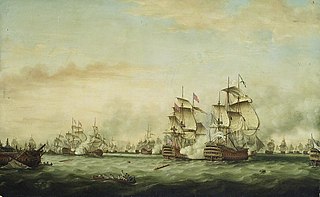Six ships of the Royal Navy have been named HMS Victory:
In addition, a number of shore establishments were named HMS Victory (as many as eight during the First World War). [ citation needed ]
Several ships and one submarine of the Royal Navy have borne the name HMS Dreadnought in the expectation that they would "dread nought", i.e. "fear nothing". The 1906 ship, which revolutionized battleship design, became one of the Royal Navy's most famous vessels; battleships built after her were referred to as 'dreadnoughts', and earlier battleships became known as pre-dreadnoughts.
Six ships of the Royal Navy have borne the name HMS St Albans after the English city and ducal family of St Albans:
Eleven vessels, and one planned, of the British Royal Navy have been named HMS Gloucester, after Gloucester, the city in England.
Several vessels of the Royal Navy have been named HMS Nonsuch, presumably named after Nonsuch Palace:
Five ships of the Royal Navy have been named HMS Barfleur after the Battle of Barfleur:

HMS Barfleur was a 90-gun second-rate ship of the line of the Royal Navy, designed by Sir Thomas Slade on the lines of the 100-gun ship Royal William, and launched at Chatham Dockyard on 30 July 1768, at a cost of £49,222. In about 1780, she had another eight guns added to her quarterdeck, making her a 98-gun ship; she possessed a crew of approximately 750. Her design class sisters were the Prince George, Princess Royal, and Formidable. She was a ship of long service and many battles.

HMS Victory was a 100-gun first-rate ship of the line of the Royal Navy, built to the dimensions of the 1733 proposals of the 1719 Establishment at Portsmouth Dockyard, and launched on 23 February 1737.
Eight ships of the Royal Navy have been named HMS Royal George after various members of the House of Hanover. A ninth was renamed before being launched:
Twelve ships of the Royal Navy have borne the name HMS Elizabeth. Most of these ships have been named in honour of Queen Elizabeth I of England:

HMS Royal Charles was a 100-gun first-rate ship of the line of the Royal Navy, designed and built by Sir Anthony Deane at Portsmouth Dockyard, where she was launched and completed by his successor as Master Shipwright, Daniel Furzer, in March 1673. She was one of only three Royal Navy ships to be equipped with the Rupertinoe naval gun.
HMS Royal James was a 100-gun first-rate ship of the line of the Royal Navy, designed by Sir Anthony Deane and built by his successor as Master Shipwright at Portsmouth Dockyard, Daniel Furzer, and launched in 1675. She was renamed HMS Victory on 7 March 1691 after the old second rate Victory of 1666 was condemned by survey and taken to pieces. Recommissioned in January 1691 under Captain Edward Stanley, as the flagship of Admiral Sir John Ashby she participated in the Battle of Barfleur on 19 May 1692 – 24 May 1692.
Several ships of the Royal Navy have borne the name HMS Royal James:

Victory was a great ship of the English Navy, launched in 1620 and in active service during the seventeenth century's Anglo-Dutch Wars. After an seventy-year naval career, she was broken up at Woolwich Dockyard in 1691 and her timbers reused in other vessels.
HMS Gloucester was a 60-gun fourth rate ship of the line built for the Royal Navy during the 1690s. She spent most of her career in the West Indies and participated in the 1701–15 War of the Spanish Succession. The ship was hulked in 1708 and broken up in 1731.

HMS Burford was a 70-gun third rate ship of the line of the Royal Navy, built at Deptford Dockyard to the 1719 Establishment, and launched on 19 July 1722. Burford was notably the early posting of both John Forbes and John Byng, both of whom rose to become Admirals.

HMS Neptune was a 90-gun second rate ship of the line of the Royal Navy, built at Portsmouth Dockyard to the draught specified by the 1745 Establishment as amended in 1750, and launched on 17 July 1757.
Five ships of the Royal Navy have borne the name HMS Harwich, after the town of Harwich. A sixth was planned, but renamed before entering service:

HMS Victory is a 104-gun first-rate ship of the line of the Royal Navy, ordered in 1758, laid down in 1759 and launched in 1765. She is best known for her role as Lord Nelson's flagship at the Battle of Trafalgar on 21 October 1805.